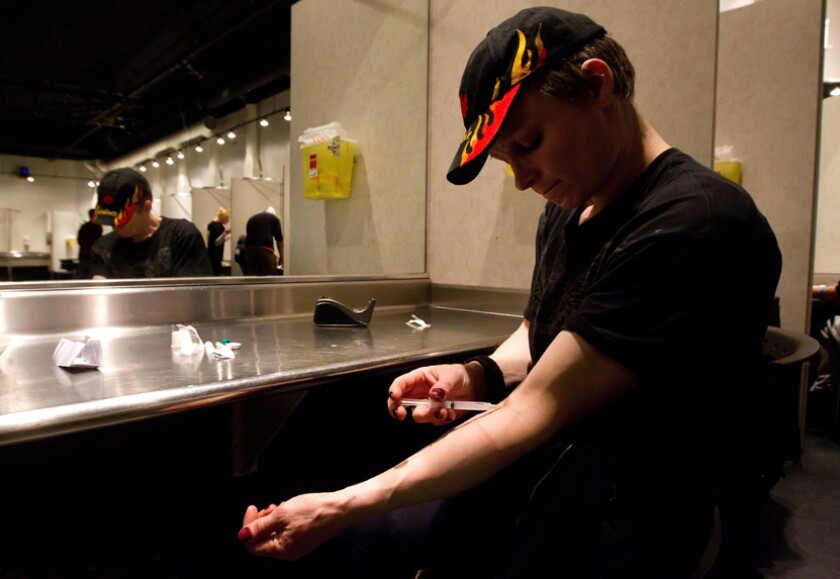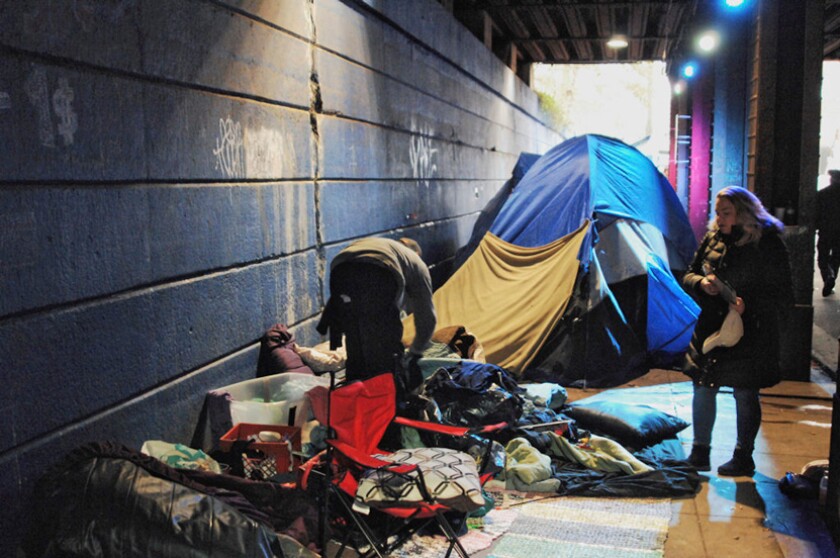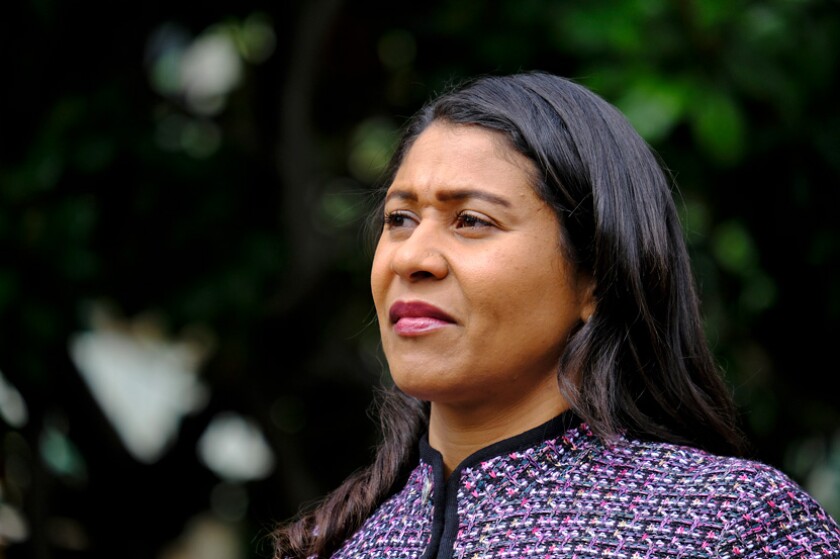One storefront on Hastings houses a small facility that at first glance seems like any traditional community health clinic. Inside the door is a reception area with mismatched chairs and murals on the wall. In the back, beyond a partition, there’s a larger room with a big central conference table and half a dozen small cubicles along the wall. The clinic is run by volunteer health workers, trained in reversing drug overdoses and testing opioids for lethal chemicals.
But this is not a health clinic. It’s the Overdose Prevention Society, a safe consumption site where intravenous drug users are welcome to come in and shoot up with no questions asked. The volunteer health workers are on hand to make sure users don’t overdose, and to dress any wounds from needle use. On this Wednesday morning, most of the cubicles are in use; the people sitting in them are injecting themselves with various opioids. A couple more sit at the conference table, riding out their highs and staring off into space. Near the back exit, two staffers huddle over a computer and a lab machine, testing the street drugs for lethal substances such as carfentanil and fentanyl, a synthetic opioid 50 times more potent than heroin that started becoming commonplace in overdoses about five years ago.
Vancouver opened the first safe injection site in North America in 2003, in response to an HIV outbreak in British Columbia. It’s called Insite, and it’s just up the street from the Overdose Prevention Society. Insite is more akin to a full medical facility, with a team of at least 10 professionals at any given time, and a detox center on site. There are treatment beds, and the staff can connect users to addiction services, counseling and other resources. It’s open until 3 a.m. seven days a week, and 24 hours a day during the week when social welfare checks are distributed and drug use spikes. Insite is supported by the Vancouver health authority, and its legal status has been legitimized over the years: After the minister of health in Ottawa tried to shut Insite down in 2006, the Canadian Supreme Court unanimously affirmed its legality, ruling that shuttering the clinic would have an immediate negative public health impact.
“It’s now ubiquitous in the community, and really a point of pride,” says Insite manager Darwin Fisher. In some circles, it’s even hip: One trendy local boutique sells T-shirts and tote bags with a needle emblazoned across the front and the words “Be Safe. Inject at Insite.”

But the Overdose Prevention Society, which opened in 2016, represents a new kind of approach -- smaller, nimbler “pop-up” sites that the city has approved in recent years in response to the ongoing opioid epidemic. Some 1,500 people died from overdoses in British Columbia in 2018, roughly the same number as the year before. Eighty-five percent of those deaths were from lethal amounts of fentanyl. In an effort to reduce the number of overdoses, Vancouver has opened six new safe consumption sites since late 2016. They don’t offer the same medical expertise or recovery services that Insite does. But the city regards them as something of a temporary triage in the battle against opioids. They’re easy to set up and can be located (and relocated) where they’re most needed. When overdose victims began showing up in one alleyway, officials drove in a trailer and began inviting people to inject there in order to keep a close watch. Another was sited next to a hospital where many overdose victims seek care. Yet another is restricted to women, to reduce the incidence of being in an incapacitated state around men who may harm them.
Canadian officials seem to be embracing the idea of pop-up injection sites. Since the Overdose Prevention Society and other clinics opened in Vancouver, similar facilities have been set up in Montreal, Toronto and other cities. There are now around 25 across Canada -- including in more conservative provinces. At these newer pop-up sites, the main focus is simply on keeping people from dying. “Previously, we had dead bodies in an alley,” says Mark Lysyshyn, a medical health officer at Vancouver Coastal Health, the regional public health authority. “Now we have an overdose consumption site, and people are alive.”
Sarah Blyth echoes that sentiment. Blyth, a well-known community activist in Vancouver, started the Overdose Prevention Society and still runs it today. She seems to know everyone who walks through its door by name, making small talk with them as they shuffle in from outside. She believes safe consumption sites are “the first step into recovery,” and the drug-purity testing services they offer mean that users “will know if they’re taking really terrible stuff.” But the most important value of these facilities, she says matter-of-factly, is simple: “No one dies at these sites.”
That seemingly straightforward proposition is about to be tested south of the Canadian border: Several U.S. cities are actively exploring the possibility of setting up a safe injection site. Half a dozen American cities in the past few years have announced plans to open a supervised consumption site. So far none has, but it’s possible that the first could be up and running by the end of this year.
It’s hard to overstate just how controversial that would be. There are an estimated 100 supervised consumption sites worldwide, mostly in Europe. While the idea has become more accepted there and in Canada, it remains wildly divisive in the United States. Giving junkies a free, comfy spot to inject themselves with illegal drugs not only condones drug use, critics say, it encourages more of it. And supervised clinics would invite crime and other illicit activities wherever they’re located. The Trump administration has threatened to arrest any city officials who open a safe injection site.
But many health workers see it as their best hope to stanch a worsening crisis. More than 70,000 Americans died from drug overdoses in 2017, and the number of fentanyl deaths has been doubling every year since 2013, according to new data from the Centers for Disease Control and Prevention. Although the death rate is still highest among white people, the sharpest increases have been among African Americans (whose fentanyl death rate increased an average of 141 percent each year from 2011 to 2016) and Hispanics (whose rate rose 118 percent on average over the same period).
In the face of harsh numbers like those, officials ought to be doing anything in their power to keep more people from dying, say many health experts. “Our overdose rate in Philadelphia is triple our homicide rate,” says Jose Benitez, director of Prevention Point, Philadelphia’s needle-exchange program. “We need to be real with ourselves that fentanyl has changed everything. We need to respond accordingly.”

Philadelphia’s Kensington neighborhood may be home to the nation’s first safe injection clinic. (AP)
Philadelphia, in fact, may become the first U.S. city to actually see a supervised site open its doors. A nonprofit called Safehouse has vowed to open a clinic in the city by the end of 2019.
The group was created by community health leaders who decided to circumvent state legislation by creating their own privately funded supervised injection site. Safehouse was trying to fundraise $1.8 million and was working with community leaders to find a proper location for a clinic. Then in February, a federal prosecutor in the city filed a lawsuit against the group; U.S. Attorney William M. McSwain said at a press conference that “normalizing the use of deadly drugs like heroin and fentanyl is not the answer to solving the opioid epidemic.”
Philadelphia’s mayor, health commissioner and district attorney have all voiced support for Safehouse. “We are not going to prosecute people who are trying to stop people from dying,” Philadelphia District Attorney Larry Krasner said after the lawsuit was filed. “We had 1,200 people die last year. I think it is inexcusable to play politics with their lives.” Pennsylvania state leaders remain wary; Gov. Tom Wolf last fall said injection clinics were “not a workable solution.” Former Gov. Ed Rendell, however, sits on Safehouse’s board.
At issue is a 1986 federal law known as the “crack house statute,” which prohibits making any property available “for the purpose of unlawfully manufacturing, storing, distributing, or using a controlled substance.” That includes safe injection sites, the federal government argues.
Safehouse has pledged to proceed anyway, despite the legal uncertainty. In late March, the group announced it had found a site for the clinic in Kensington, a neighborhood at the heart of Philadelphia’s opioid crisis. (A local developer announced plans to donate the space to Safehouse, rent-free.) “We’re moving forward,” says Safehouse vice president and secretary Ronda Goldfein, adding that she feels heartened that the lawsuit is a civil procedure and not a criminal case. “We have no money and we’re being sued, but we’re moving forward.”
Local leaders across the U.S. are watching. After fentanyl began showing up more prevalently in overdoses, several cities began exploring the idea of a safe consumption site. Seattle officials were the first to formally greenlight a plan. Boston, Denver, New York and San Francisco have also discussed the idea. None of those proposals has gotten very far. In Seattle, logistical challenges of funding and securing a site have stymied plans for a clinic. California legislators last year approved a law allowing San Francisco to pilot a site, but it was vetoed by Gov. Jerry Brown, who said he simply didn’t believe such a facility would reduce drug addiction; lawmakers have taken up an almost identical bill this year, and new Gov. Gavin Newsom has voiced support for it. In Massachusetts, a state task force in February recommended to Gov. Charlie Baker that the benefits of opening a safe injection site outweigh the concerns; Baker remains opposed to the idea, and one state representative who served on the task force says it will likely be “a long road” before such a facility could open in Boston. In New Jersey, meanwhile, lawmakers are considering a bill that would allow a yearlong pilot of four different injection sites.

San Francisco Mayor London Breed has vowed to open a supervised consumption clinic in her city. (AP)
Many of the officials who object to safe injection sites, including Brown and Baker, have cited the federal government’s opposition to them as part of their reasoning. What’s the sense in trying to open a clinic that the feds have vehemently vowed to shut down? Because of that, some health experts say they’re actually glad to see the current lawsuit in Philadelphia. “I think it’s a really helpful development,” says Jessica Gaeta, chief medical officer at Boston Healthcare for the Homeless. “The crack house statute in question wasn’t written to address public health impacts of an overdose. I think it’s a healthy thing that this conversation is happening in the courts now, as opposed to if it opened and there was litigation brought against people.”
Of course, even if the courts do determine that injection sites violate federal law, some cities could decide to open a clinic anyway, especially if state legislation in places like California or New Jersey were to give them cover. After all, marijuana remains illegal under federal law, and two different presidential administrations have now allowed dispensaries and cannabis shops to continue operating in 33 states and the District of Columbia.
Most Americans right now oppose supervised injection sites. A 2018 study from Johns Hopkins University found that only 29 percent of people approve of them, with 39 percent of people supporting similar programs like clean needle exchanges.
Nonetheless, there is a growing consensus among researchers that these facilities work. No one has ever died at any safe consumption site around the world. In Vancouver, studies over the years have shown that Insite has reduced overdose deaths by 35 percent and has resulted in a 30 percent increase in the number of people seeking treatment for addiction. As for the concern that clinics beget crime and homelessness, numerous studies have found that conditions in the neighborhood around Insite have largely remained the same. In fact, in the past two decades that facilities like Insite have proliferated across the world, there has only been one study that was critical of supervised injection clinics, which found that they didn’t have a significant impact on mortality or syringe sharing. But that study was retracted by The International Journal of Drug Policy a month after publication for “methodological weaknesses.”
“We have hundreds, if not thousands, of people walking around Vancouver who wouldn’t be around if not for safe injection facilities,” says M-J Milloy, a research scientist with the British Columbia Centre on Substance Use who has studied Insite’s impact in Vancouver.
Research on the impact that such sites would have in the United States is limited, but generally favorable. One study published in The American Journal of Preventive Medicine found that a supervised consumption site would save the city of San Francisco $3.5 million in annual health-care and emergency services costs, and would drastically reduce public injection and discarded needles.
“A lot of this work hasn’t been surprising, because it mirrors research that’s come out of Canada,” says Alex Kral, an epidemiologist at the University of California, Berkeley, who has extensively studied the issue. “There’s nothing about Insite that couldn’t work in America. With us having 70,000 deaths, in my mind those numbers are enough for us to try it.”
Fisher, the Insite manager, says he understands the hesitancy to open a similar clinic in the United States. It’s an entirely new paradigm on harm reduction, requiring most people to recalibrate the way they view drug users, addiction and treatment. “We’ve spent a hundred years telling these people to go away, to live on the margins, to do this procedure in egregious situations in the most unsafe places in cities,” he says. The central truth of supervised consumption sites, he says, is that “these places acknowledge the existence of these people.”









